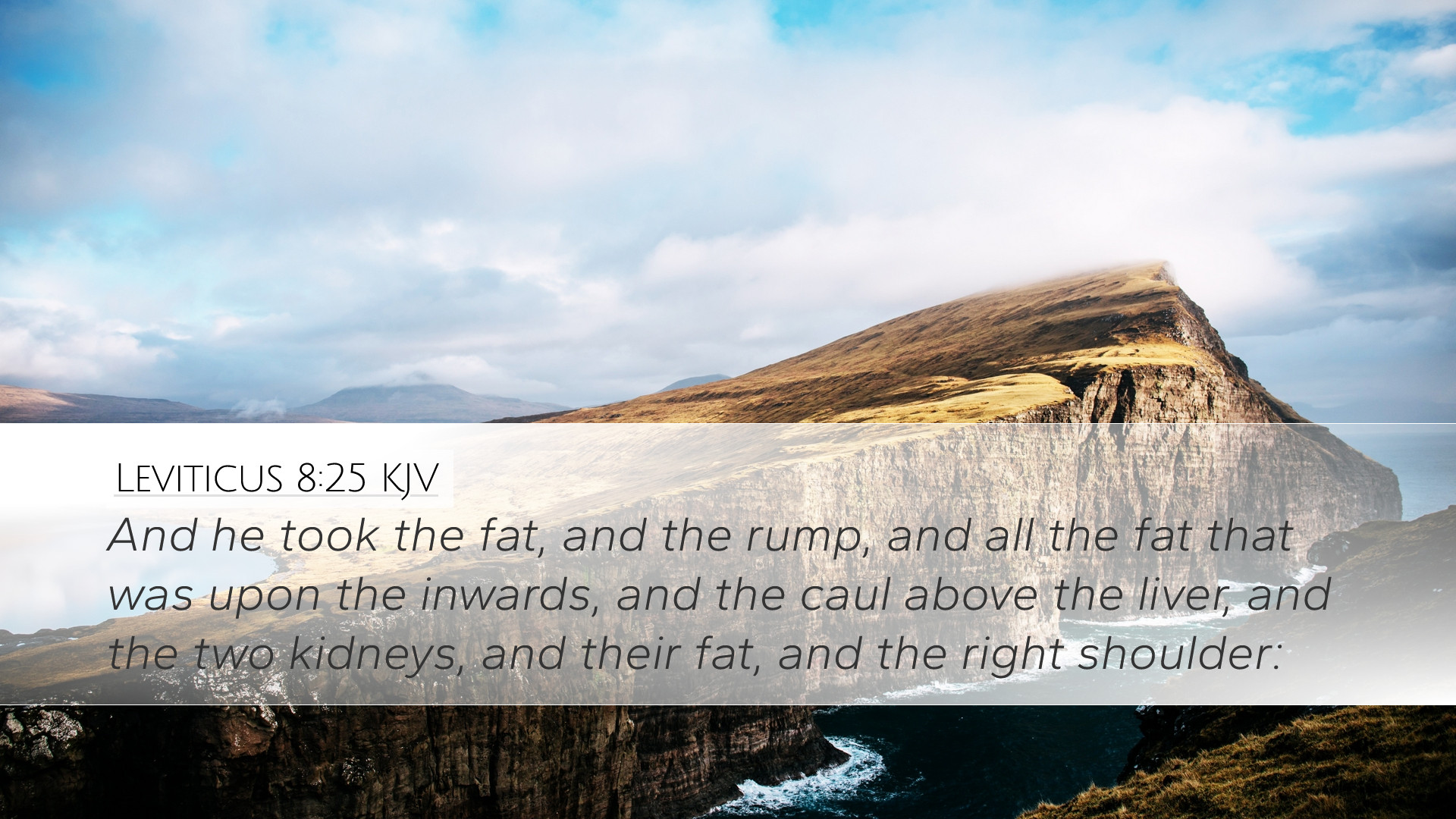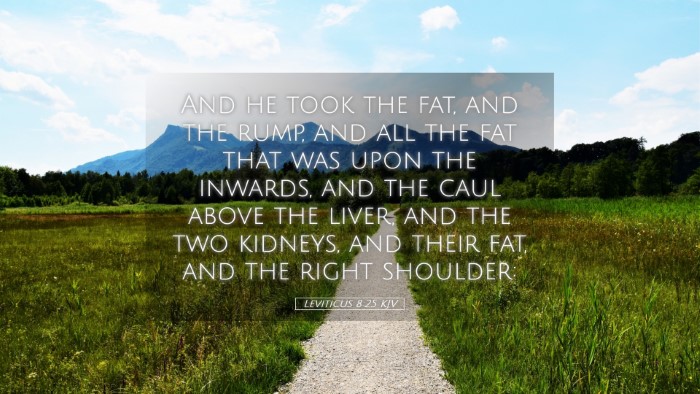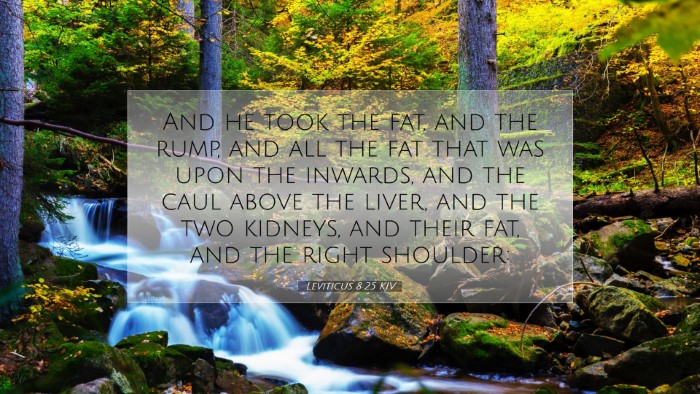Commentary on Leviticus 8:25
Verse: "And he took the fat, and the fat tail, and all the fat that was upon the inwards, and the caul above the liver, and the two kidneys, and their fat, and Moses burned it upon the altar." (Leviticus 8:25, KJV)
Introduction
Leviticus 8 details the consecration of Aaron and his sons as priests, a pivotal moment in the establishment of Israel's worship structure. The offerings described in this chapter serve not only as ritualistic acts but also as profound symbols of dedication and atonement. In Leviticus 8:25, the focus is on the sacrificial offerings made by Moses, which signifies the divine approval of the priestly order and the sanctifying presence of God.
Commentary Overview
This verse provides a detailed description of the offerings made during the consecration ceremony. Each component of the offering holds theological significance and reflects the broader themes of holiness, sacrifice, and God's covenant with His people.
1. The Fat and Its Symbolism
Matthew Henry emphasizes the role of fat in sacrifices, noting that it represents the best part of the animal. In ancient Israelite culture, fat was considered a delicacy and was often associated with abundance and blessings. Thus, its offering signifies giving God the best as an act of worship.
Albert Barnes adds that fat in sacrificial offerings symbolized the fullness of life and the richness of God's bounty. The act of presenting fat is an acknowledgment of God's provision and a desire for His favor. In this light, the burning of fat signifies a complete offering, consumed by fire, representing its total dedication to the Lord.
2. The Process of Sacrifice
Adam Clarke describes the sacrificial process as not merely a ritualistic task but a deeply spiritual act. Moses, as the mediator, carefully follows the prescribed ritual, which demonstrates the importance of obedience to God’s commandments. Clarke notes that every detail matters in the sacrificial system, reflecting the seriousness of sin and the need for atonement.
The act of burning the offering on the altar represents total surrender and acceptance by God. This fire both purifies the offering and signifies God’s consuming presence, which is a theme prevalent throughout the sacrificial system.
3. The Fat Tail and Its Significance
The specific mention of the fat tail is noteworthy. In Israelite culture, the fat tail of certain animals, like sheep, was highly prized. Matthew Henry discusses how this part symbolizes the entirety of one's life. By offering the fat tail, the priests were demonstrating their willingness to dedicate not just a portion, but their whole being to God’s service.
4. The Inwards and Their Role
The reference to the inwards suggests the need for internal purity. Albert Barnes notes that offering the inwards—often seen as the seat of emotions and desires—points to a deep, heartfelt commitment to God. This aligns with the biblical idea that God desires truth in our inner parts (Psalm 51:6).
5. The Overall Context of Priesthood
This verse encapsulates the essence of the priestly role. The priests were not only intermediaries between God and Israel but were also symbols of the community’s relationship with God. As emphasized in Adam Clarke’s analysis, their function extended beyond ritual; they were to embody holiness and be living sacrifices representing the people.
The act of sacrifice, particularly in a public setting, reinforced communal identity and the shared responsibility of maintaining holiness in the camp. This verse contributes to understanding how the Hebrew Bible articulates the connection between sacrifice, community, and divine favor.
Theological Implications
The act of sacrifice signifies atonement and reflects broader themes of redemption found throughout the Scriptures. The Apostle Paul’s exhortation in Romans 12:1, to offer our bodies as living sacrifices, resonates with this call to holiness and dedication expressed in Leviticus.
1. A Foreshadowing of Christ's Sacrifice
The sacrificial system, as established in Leviticus, foreshadows the ultimate sacrifice of Jesus Christ. Matthew Henry articulates that every element of the offerings, including the burning of fat and the specific parts offered, symbolizes aspects of Christ's atoning death. Jesus, the Lamb of God, perfectly fulfilled the sacrificial requirements set forth in the Old Testament, offering Himself completely for the sins of humanity.
2. Holiness and Community
Albert Barnes discusses the communal aspect of the sacrifices, highlighting that they were not conducted in isolation but as a collective act of worship. This community aspect is vital in understanding the text's social implications; it emphasizes God’s intention for His people to live in holiness together.
The instructions given in Leviticus, including the specifics of the sacrifices, guide God's people towards a lifestyle of holiness, which influences their relationship with one another and the wider world.
Conclusion
Leviticus 8:25 serves as a poignant reminder of the significance of offering in biblical worship. The detailed descriptions of the sacrifices, as discussed by Matthew Henry, Albert Barnes, and Adam Clarke, underscore the necessity of approaching God with reverence and the understanding of His holiness.
For pastors, students, and theologians, this verse highlights the importance of obedience in worship and the profound meanings behind sacrificial acts. It calls for a deep reflection on how we present ourselves to God and how our worship can be a genuine offering of our lives.
As we contemplate this text, may we be motivated to live as holy sacrifices, reflecting the love and grace we have received through Christ, who is the fulfillment of all that the sacrificial system signifies.


